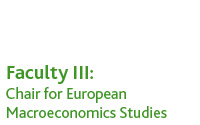Research
Working papers and work in progress
Nowcasting consumer price inflation using high-frequency scanner data: evidence from Germany (with Kai Carstensen, Jan-Oliver Menz, Richard Schnorrenberger, and Elisabeth Wieland)
Abstract
We study how millions of granular and weekly household scanner
data combined with machine learning can help to improve the
real-time nowcast of German inflation. Our nowcasting exercise
targets three hierarchy levels of inflation: individual
products, product groups, and headline inflation. At the
individual product level, we construct a large set of weekly
scanner-based price indices that closely match their official
counterparts, such as butter and coffee beans. Within a
mixed-frequency setup, these indices significantly improve
inflation nowcasts already after the first seven days of a
month. For nowcasting product groups such as processed and
unprocessed food, we apply shrinkage estimators to exploit the
large set of scanner-based price indices, resulting in
substantial predictive gains over autoregressive time series
models. Finally, by adding high-frequency information on energy
and travel services, we construct competitive nowcasting models
for headline inflation that are on par with, or even
outperform, survey-based inflation expectations.
Available as ECB working paper at:
https://www.ecb.europa.eu/pub/pdf/scpwps/ecb.wp2930~05cff276eb.en.pdf?fe0a072f86258f7c499e7a397d88db61
Prices and global inequality: New evidence from worldwide scanner data (with Xavier Jaravel and Liuxiu Liu)
Abstract
How do prices affect inequality and living standards worldwide?
To address existing biases in the measurement of prices and
expenditure patterns across countries, this paper introduces a
new global scanner database. This dataset provides harmonized
barcode-level data on expenditures and prices for fast-moving
and slow-moving consumer goods during the last decade in thirty
four countries, which include both developing (e.g., Brazil,
China, India, and South Africa) and developed countries (e.g.,
the United States, Russia, and most European countries) and
represent 70% of world GDP and 60% of world population. We rst
quantify the importance of several common biases stemming from
substitution, product variety, and taste shocks, and we
characterize how these biases vary with the level of economic
development. We then build purchasing power parity indices
using identical barcodes across countries. We find that
adjustments for product variety, non-homotheticities, and taste
heterogeneity are quantitatively important. Overall, these
findings indicate that using micro data on prices and
expenditures is crucial to accurately describe patterns of
inclusive growth worldwide.
Pass-through of local corporate taxes to consumer prices: Evidence from German micro data (with Sebastian Kessing, Sebastian Siegloch and Malte Zoubek)
Abstract
Tax incidence, i.e. the question of who bears the burden of a
particular tax, has been a classic topic in public finance, and
it is intricately linked to tax pass-through- Our paper
quantitatively evaluates whether, and to what extent, firms can
shift corporate taxes to prices. Conceptually, this requires a
setting of imperfect competition. This is empirically plausible
but has been somewhat neglected in most of the modern
literature on corporate tax incidence, building on Harberger’s
(1962) seminal analysis. Recent studies have shown empirically
that workers bear a substantial share of the burden of
corporate taxes (approximately 30-50%, see Fuest et al. (2018),
and Suarez Serrato and Zidar (2016)). This raises the question,
whether the remaining burden will be borne by capital, or
whether this burden may be shifted upstream to suppliers or
downstream to customers and final consumers. The project
focuses on the latter channel, i.e. the pass-through rate of
corporate taxes to prices, for which no convincing empirical
evidence exists.
Price and quantity effects of a temporary VAT cut: Evidence from scanner data on durables and non-durables (with Muzammil Hussain, Xavier Jaravel, Sebasting Kessing, and Sebastian Siegloch)
Selected publications in refereed journals
Price gaps at the border: evidence from multi-country household scanner data (with Hans-Helmut Kotz and Natalia Zabelina), Journal of International Economics, Vol. 127, 2020. Online version | Working paper version | Replication folder.
Price elasticities and demand-side real rigidities in micro data and in macro models, (with Sarah M. Lein), Journal of Monetary Economics, Vol. 127, pages 200-212, 2020. Online version .
On the importance of sectoral and regional shocks for price-setting, (with Kirstin Hubrich and Massimiliano Marcellino), Journal of Applied Econometrics, Vol. 31(7), pages 1234-1253, 2015. Online version
Regional inflation dynamics within and across euro area countries and a comparison with the US (with Kirstin Hubrich and Massimiliano Marcellino), Economic Policy, Vol. 57, pages 141-184, 2009.
Central bank misperceptions and the role of money in interest rate rules (with Volker Wieland), Journal of Monetary Economics, Vol. 55, pages 1-17, 2008.
Money in monetary policy design: A formal characterization of ECB-style cross-checking (with Volker Wieland). Journal of the European Economic Association, Vol. 5(2-3), pages 524-533, 2007.
Learning and control in a changing economic environment (with Volker Wieland). Journal of Economic Dynamics and Control, Vol. 26 (9-10), pages 1359-1377, 2002.
Publications in monographs
Money in monetary policy design: Monetary cross-checking in the New-Keynesian model (with Volker Wieland). Published in: V. Wieland (Ed.), The Sience and Practice of Monetary Policy Today, Springer Science, 2010.
Selected policy-related publications
Less activites de shadow banking dans un contexte de bas taux d’interet: une perspective de flux financiers’ (Euro area shadow banking activities in a low- interest-rate environment: a flow-of-funds perspective) (with Hans-Helmut Kotz). Revue d’Economie Financiere, pages 235-256, 2016.
Lost in translation? ECB’s monetary impulses and financial intermediaries’ responses (with Hans-Helmut Kotz and Natalia Zabelina) . SAFE White Paper No. 37, 2016.
Euro area macro-financial stability: A flow-of-funds perspective (with Hans- Helmut Kotz and Natalia Zabelina). SAFE White Paper No. 29, 2015.
Older contributions (that still have some relevance)
Inflation dispersion and convergence in monetary and economic unions: Lessons for the ECB (with Axel A. Weber). | Download: PDF Version
Price Stability, Inflation Convergence, and Diversity in EMU: Does One Size Fit All? (with Axel A. Weber). | Download: PDF Version
